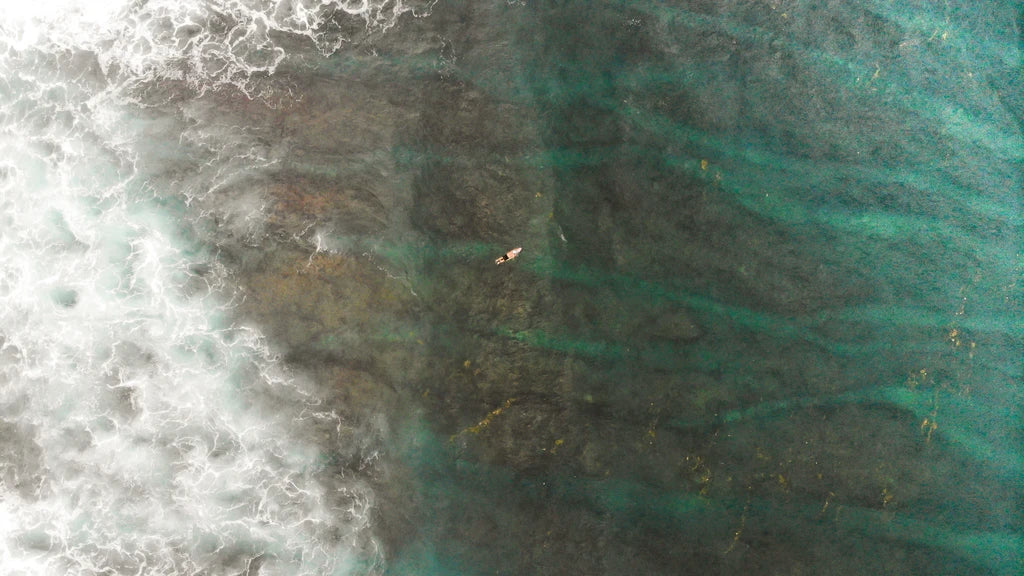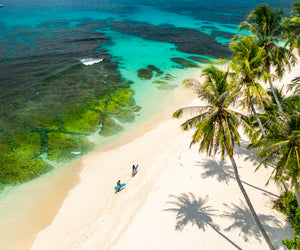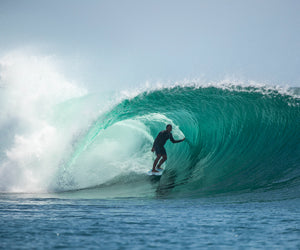The Drifter Journals
Hold Your Breath | Apnea For Surfers
Let’s face it: none of us is getting any younger.
When we’re in the halcyon days of youth, we are impervious to injury, dauntless to danger, and insusceptible to self-preservation. We will throw ourselves into, onto, over and under any heaving wave that the ocean can throw at us.
But as time wears on and responsibilities rise in relativity to dwindling fitness and expanding waistline, we tend to be a little less invincible-slash-stupid.
There’s no fixing this - life is what it is and, aside from spending gruelling hours at the gym day in and day out, our levels of fitness are going to wane. This can have a big effect on our surfing. Endurance is just down to breaking sweat and doing the time, but there’s a little hack that is easy to learn and quick to benefit; apnea.

Photo: @kimi_swimmy by @cinematowski
Apnea, so Wikipedia tells us, is the cessation of breath...when there is no movement of the muscles of inhalation. Obviously, we hold our breath when we duckdive, cop a set on the head or go over the falls, so we’re already practicing apnea to some degree, but training in it, making your breath-holds better, longer and more comfortable, is an amazing and simple way to step up our surfing game.
Most people come to apnea through want for freediving. Apnea training was developed to increase the human ability to stay underwater. Spearfishers also get great benefit from apnea training so that they can stay down for longer and improve their chances of nabbing tonight’s dinner. But surfers don’t stay down that long, and the idea of holding your breath for two minutes plus is kind of pointless.

Photo: @tommyschultzphoto
But apnea training is a twofold lesson.
“Apnea helps you to develop self-awareness, self-control and forge body and mind resilience through the mastery of breathing and apnea,” says Drifter’s favorite apnea guru and founder of Survival Apnea, Augusto Vegas.
“Apnea practice will improve your ocean fitness, but more than that, it will help you to remain calm and controlled during hold-downs, endure better through challenging moments, such as when paddling through a set of waves, sharpen your presence and focus, and give you far more control over anxiety and apprehension.”
Augusto’s apnea trainings cover all aspects of freediving and survival apnea - being able to remain controlled and unphased in pressure situations. The comprehensive courses, both in-person and online, provide the perfect foundation for all ocean-goers, whether you freedive and spearfish, or even if you choose to spend most of your time above the waves.

“Anyone interested in improving their surfing, deepening their connection to nature and experiencing their real potential should consider an apnea course,” suggests Augusto.
“All Survival Apnea exercises are very simple and effective training tools. They can easily be practiced in and/or out of the water in the comfort of your home.”
There are two primary breath lessons that you can easily and safely do without any official training that will already begin to improve your abilities. These ‘dry training’ lessons focus on two specific medical conditions: hypoxia - a lack of oxygen - and hypercapnia - an excess of carbon dioxide. These lessons, what are known as O2 and CO2 training, or tables, begin to train your body to better manage periods below the surface.

Photo: Childs
O2 training is great. It helps you increase your lung capacity, improves your cardiovascular fitness and elevates your stamina; all things that are very useful as a surfer.
CO2 training, on the other hand, is a game-changer. With even some very simple, self-initiated training, you will find that heavy situations are infinitely easier. Rather than allowing you to hold your breath for greater lengths of time (which is an incidental side effect), CO2 training allows you to be comfortable in the situations you need it most: wipeouts.
When we hold our breath, especially when exercising, carbon dioxide and lactic acid build up in our bodies. Breathing out expels the carbon dioxide, breathing in oxygenates our muscles, relieving the lactic buildup. It is these - mostly the elevated CO2 - and not a lack of oxygen that tell our bodies we need to breathe.
When we get wiped out or held underwater and begin to panic and scramble for the surface, it’s not our need for oxygen that sends us into a spin, it is simply our body sensing the carbon dioxide and telling us we need to breathe, even though, at least initially, we don’t.

Photo: @mironovad
It’s a mind-over-matter scenario. Of course, breathing is quite helpful for our survival, but our body’s reaction is almost excessively over-reactive, preempting our urge to breathe far sooner than is actually required. As soon as it senses more CO2, especially when our mind knows that we are unable to breathe - such as when we are underwater - it causes the diaphragm to palpitate, the chest to heave and the throat to strain, preparing to take that gasping breath when you finally break the surface.
That discomfort, that feeling of “I need to breathe” can be overcome. It is a knee-jerk reaction that takes place almost subconsciously, but one that comes much earlier than is necessary. Even when we’re out of breath on dry land, holding for 20 seconds is easy. But put your head underwater, in a situation where breathing isn’t an option, and even 10 seconds can seem like forever.
Funnily enough, but perfectly illustrating this subconscious connection, it’s often in smaller conditions that panic can be more likely to take hold.

If we are surfing big waves, we are more psychologically prepared to take a beating. We know it is almost an inevitability, so we are better mentally ready to simply roll with it. On smaller days, we tend to be far more nonchalant and, caught off guard, we can often find ourselves in uncomfortable, though very rarely life-threatening, situations, struggling for the surface and panicking.
CO2 training overcomes the knee-jerk reaction, training your mind and body to be comfortable with increased levels of carbon dioxide in a safe, dry environment so that the next time you’re held down, all those feelings of panic and a desperation to breathe are both familiar and manageable.
The turn-around is quick too. You don’t have to be training for years to get good at it. In fact, you’ll notice significant improvements within only a month or two.
The best news is that you don’t need to attend any classes, you don’t need a teacher and you don’t need any apparatus. You can practice it anywhere and all you really need is the stopwatch on your phone.
STAmina is an excellent app to track your progress and measure your sessions. The paid app gives you the option of both O2 and CO2 training, has auto-generated tables and is fully customisable. It’s a very convenient way to go, but a simple stopwatch will also do the job.
Here is a simple CO2 table to get you started. As this becomes easier, increase the length of your breath holds and the number of repetitions:
BEGINNER’S CO2 TRAINING TABLE
Find a relaxed position. Sitting, lying down - doesn’t matter - you just need to be relaxed.
1. Breathe easily for 1:20 mins
2. Hold for 1:15
3. Breathe for 1:10 mins
4. Hold for 1:15
5. Breathe for 1:00 min
6. Hold for 1:15
7. Breathe for 50 secs
8. Hold for 1:15
9. Breathe for 40 secs
10. Hold for 1:15
11. Breathe for 30 secs
12. Hold for 1:15
13. Breathe for 20 secs
14. Hold for 1:15
15. Breathe for 10 secs
16. Hold for 1:15
17. FINISH
Repeat every other day.

There are other ways you can train as well, such as apnea walking. Find a nice, safe area, such as on a wide beach with soft sand. Sit and relax, take a deep breath and hold. When you get your first diaphragm flutter - that feeling of “I need to breathe” - get up and start walking. Go as far as you can until you absolutely have to breathe. Repeat this six to eight times, resting for a while in between and trying to walk a little further each time.
THIS IS WHERE YOU REALLY NEED TO PAY ATTENTION THOUGH:
You’re holding your breath. You are trying to overcome the reactions and signals that our bodies have evolved over millions of years for a very good reason: to keep us alive!
With dry apnea training, unless you’re going to extreme lengths, the worst that is likely to happen is that you momentarily black out. But even this can be dangerous.
If you’re near any hard surfaces, sharp edges or if you decide to apnea walk beside a road, even a split-second black-out could be hazardous.
Following a simple CO2 table in the comfort of your home is an excellent way to begin building your CO2 tolerance, and may well be all you want or need to step up your surfing game. If you want to take it further on dry land, find someone also interested in apnea and search out a simple first aid course, so that you are trained for every possibility.
If you plan to do any wet training with your face submerged in any water at all, from your bathroom sink to the open ocean, you MUST seek professional help.
“Doing a proper course will provide students with strong foundations to understand the benefits of the breathing and apnea practice, how to train to get solid results and learn how to apply these adaptations in real life scenarios,” says Augusto.

Starting on your own at home is an excellent way to begin your apnea journey, but nothing is going to be more effective - or safe - than investing in a Survival Apnea course. Under trained instruction, you will develop skills far more rapidly and, when you begin your wet training - in a pool or the open ocean - you will be expertly taught with professionals always on hand should anything occur or you panic.
We recommend visiting survivalapnea.com and getting started with the Surf Survival Kickstart Bundle, which includes the Surf Survival Online Course and Surf Survival online Training Program, a 4-Week cycle program that provides you with the ideal, professional foundation to get your apnea journey kickstarted.

So whether you just count the seconds while lying on your bed or take the plunge and invest in a Survival Apnea course, learning how to breathe - or more importantly, how not to - could be the simple trick you need to take your surfing into new realms, bigger waves and with greater confidence.
MEDICAL WARNING: Apnea, even in its simplest form, can be dangerous. If you have respiratory conditions, heart conditions, high blood pressure or other underlying issues, consult a medical professional before undertaking any form of breath training. Always practice apnea in a safe environment and ONLY practice wet training with a trained professional.
Augusto Vegas hosts regular apnea training sessions in Uluwatu, at Mana Cafe. His next courses are on 14 August and a Russian-language training on 21 August, 2020.
For more information, or to enrol in a Survival Apnea online course, visit survivalapnea.com
Article written with assistance from and thanks to Russel Pollard - @bornwithgills




